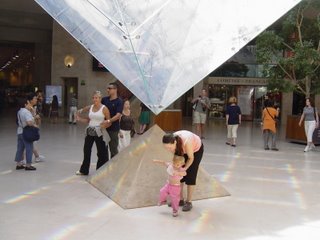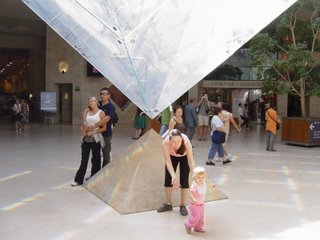 Here we are standing in front of the famous Louvre Pyramid, a large metal and glass pyramid which serves as the main entrance to the Musée du Louvre.
Here we are standing in front of the famous Louvre Pyramid, a large metal and glass pyramid which serves as the main entrance to the Musée du Louvre.Commissioned by then French president François Mitterrand, the Louvre Pyramid was built in 1989 by the architect I. M. Pei from New York, who also designed the Miho Museum in Japan. The structure is constructed entirely with glass segments, and reaches a height of 20.6 meters (about 70 feet). It consists of 603 rhombus-shaped glass segments, and 70 triangle shaped glass segments.
One much appreciated perk about Paris is that if you go to a musem with your child, you don't have to wait in line. You can go to the front of the line, and they'll let you right in ahead of everyone else standing in line.
On a side note, I wanted to mention that we spotted two girls sitting by the fountain (in front of the pyramid) speaking English so we asked them if they would take our photo. (And they did.) They asked us where we were from and when we told them Los Angeles, they immediately gushed that they were Americans too and from Michigan. Isn't it interesting how you have an instant connection with people from your own country when you travel abroad?
 We went into the Louvre gift shop/bookstore to buy a book for Astrid. Uwe's holding the French children's book we bought for Astrid, which has flaps you can lift up for surprises underneath, and beautiful illustrations about colors, shapes, opposites, and numbers.
We went into the Louvre gift shop/bookstore to buy a book for Astrid. Uwe's holding the French children's book we bought for Astrid, which has flaps you can lift up for surprises underneath, and beautiful illustrations about colors, shapes, opposites, and numbers.  Astrid checking out the puppets. It was a good opportunity to let her walk around, before we had to strap her into her stroller to visit the art galleries.
Astrid checking out the puppets. It was a good opportunity to let her walk around, before we had to strap her into her stroller to visit the art galleries.Funny thing about visiting the Louvre now, is I just finished reading The Da Vinci Code prior to this vacation. Uwe had read it earlier and my copy had been sitting on a bookshelf collecting dust. I had read the first chapter and couldn't get past the outrageousness of the albino monk self mutilating himself. Then I went on a business trip and had finished the book I brought with me, so I was at the mercy of the airport bookstore. The only book half interesting was The Da Vinci Code, so I bought a copy and finally finished reading it. Uwe said I was so 2005.
The reason I mention this is: In 2005, the Louvre received a record 7.3 million visitors in part due to the success of the novel The Da Vinci Code—a significant boost of 22% compared to previous figures, placing the Louvre as the most visited monument in Paris.
 Astrid happily flipping through her French book.
Astrid happily flipping through her French book.A little history lesson about the Louvre:
The structure of the Louvre was built in the Middle Ages. During the forty-three-year reign of Philippe Auguste (1180–1223), the power and influence of the French monarchy grew considerably, both inside and outside the kingdom. In 1190, a rampart was built around Paris, which was Europe’s biggest city at the time. To protect the capital from the Anglo-Norman threat, the king decided to reinforce its defenses with a fortress, which came to be known as the Louvre. It was built to the west of the city, on the banks of the Seine.
The dark fortress of the early days was transformed into the modernized dwelling of François I and later, the palace of King Louis XIV. It has been open to the public since 1793.
It's estimated that it would take a month of visits to see everything at the Louvre.

Here I am holding (sometimes wrestling) Astrid for a photo. Here she is attempting her great escape from her Handler.
Here she is attempting her great escape from her Handler.
Normally as long as she stays nearby and it's safe, I'm comfortable letting her roam around and explore on her own. However, in large crowds, and now that she can literally run off, and there's always the remote chance of abduction, I'm trying to teach her to hold my hand and stay next to me.
Photos are not allowed in the Louvre, hence I don't have any photos of the art we saw, or the umpteen galleries. The one masterpiece that I wasn't able to see, but had wanted to, was the Statue of David, as that wing was closed when we were there. But we were able to see the Mona Lisa and other famous paintings and works of art (more than I can mention without posting a long laundry list).
It's always great to see famous works of art in person with your own eyes. I'm always amazed by how big some pieces are, or in the case of the Mona Lisa, how small it is. In other instances you can see the painstaking detail and the vivid colors that many times are not evident in reproductions. It's amazing how well preserved some are. Some paintings look like they were just painted. In some of the large paintings you can see creases in the paper. I'm not sure if this is because originally they connected smaller pieces of canvas together to make one large canvas, or if the paintings were folded at one point in time. Probably a combination.

No comments:
Post a Comment